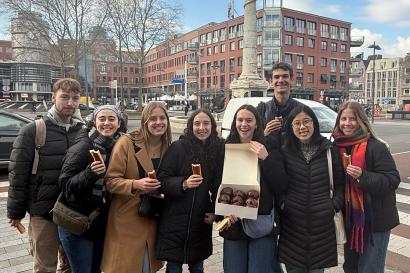Last weekend, we went to the Mercado San Roque with one of my classes. The market is housed in and around a very large warehouse-esque building with multiple levels. Everything Ecuadorians may use in their food can be found in this market. Apparently supermarkets and vendors at other markets purchase their goods here. However, it is a very dangerous market, and we had to be very cautious when taking photos.
Here's a drawing of some things I saw at the market.
As we walked into the market, there were several stands outside the entrance selling pork. There were roasted pig heads lined up in rows, and large hollowed out pig torsos (do pigs even have torsos?) filled with scraps of meat and bone. This may be the typical way to present pork, as we saw this many times at the market. We saw some of the shopkeepers scraping the meat off of the heads into bags for paying customers.
The layout inside the market was divided up like a parking lot, where each vendor has their own small lot to set up shop in. The market was set up so that vendors selling siliar items were grouped together. For example, the meat and seafood could all be found in one place (with the exception of pork, which could be found anywhere).
Right at the entrance, there were a lot of stalls selling herbs. These stalls were completely overflowing with bundles of herbs. Ecuadorians are very into traditional medicine. My host mother is always showing me what foods are good for digestion, colds, etc.
Walking by the meat and seafood stands, you see a lot of animal parts that you would not see in your typical U.S. butchershop. Cow tongues, for example, were ubiquitous. As were livers, hearts, brains, and stomachs. There were also some very pretty purple octopuses.
A man passed by us as we were perusing the stalls, leading his goat behind him. He was selling bags of fresh goats milk for 1 dollar. The goat's name was Mariposa, which means butterfly in Spanish.
We then came upon a small section of the market selling live animals, mostly intended for eating. There were large cages containing ducks and chickens, smaller boxes overflowing with baby chicks, and larger boxes contianing guinea pigs (called cuy here) and rabbits. In Ecuador, guinea pigs are quite cheap, costing 5 dollars each and are intended for eating. Guinea pigs are native to the Andes, and there are still some wild guinea pigs roaming the mountainsides.
In the live animals area, we also saw a couple of boxes full of pigeons. We asked why they were selling pigeons, and the vendor told us that they were pets. So one lesson from Ecuador: our pests are their pets, and our pets are their delicacies.

Oonagh Jordan
<p>I'm Oonagh (ooh-nah), a junior at Grinnell College, and a Political Science major who fancies herself an occasional artist and a lifelong doodler. I'm very excited and mildly terrified to start my stay in Quito, but I'm very much looking forward to immersing myself in the language and culture.</p>





